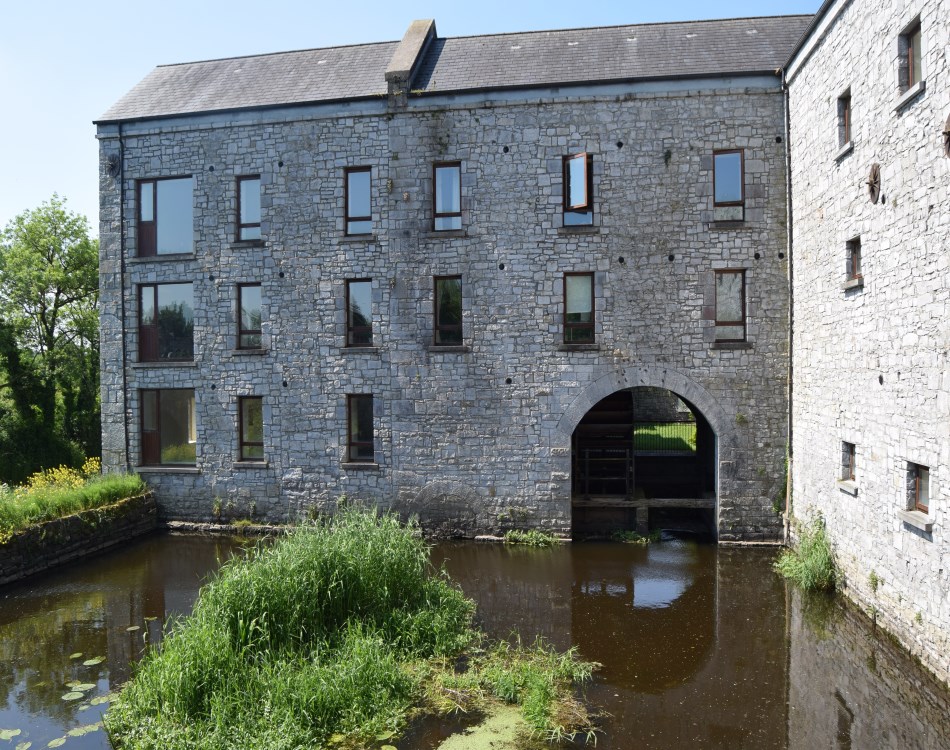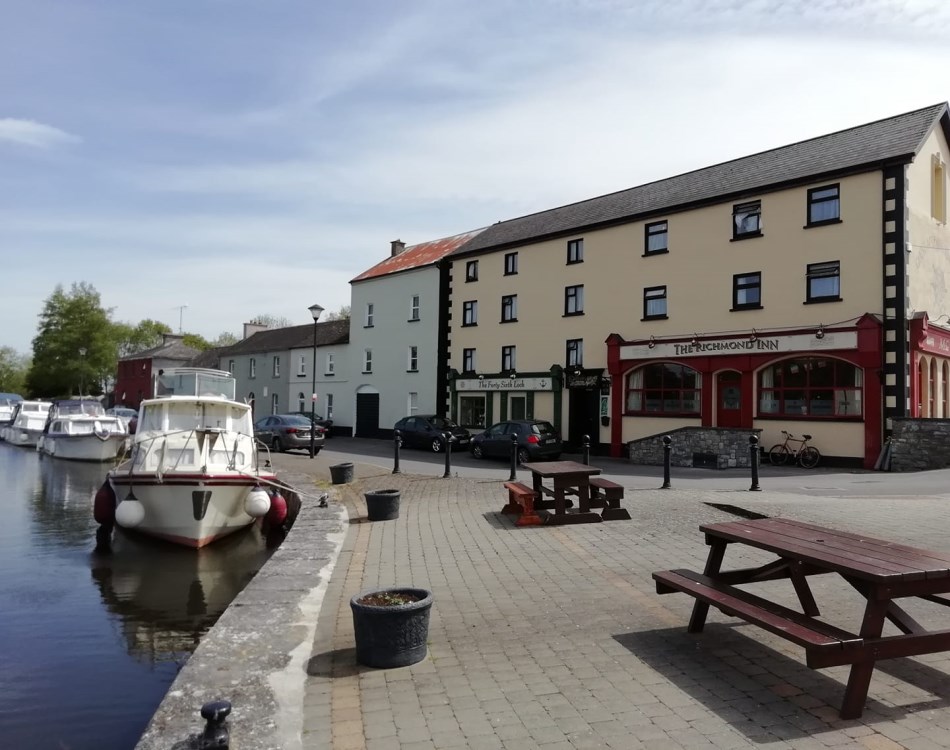Killashee & Clondra
Kilashee
This picturesque and historical village is situated about 9 kilometres to the west of Longford town. Killashee is in the same parish as Clondra. The Royal Canal crosses the Fallow River via the aqueduct at Gorteenboy.
Killashee is a neat crossroads village built around an irregular square bounded on one side by a nice three-storey, six-bay Georgian block and on the other by low two-storey C 19 dwellings.
Clondra
Clondra takes its name from the old Irish, Cluain Da Rath, which means the Meadow of Two Ringforts. It is situated on the River Camlin at the terminal of the Royal Canal. In the town is Richmond Harbour, which is forty seven locks from Spenser Lock in Dublin. The canal closed for commercial use in 1966 but there are now plans to reopen it, and this will increase the number of tourists who visit Clondra, as they will be able to travel on the canal by boat. A pretty village with a unique waterside location straddling the Royal Canal, the river Camlin and a navigation cut from the canal to the Shannon - a picture postcard of weirs, locks and water.
History
Killashee

Killashee or Cill na Sidhe when translated means ‘The Church of the Fairy Mound’ or ‘The Wood of the Fairies’. These translations could be linked to the existence of a number of forts throughout the parish and mounds or hills which overlook the village, notably ‘Carrig’, known locally as ‘Burke’s Hill, ‘Crochans’ on the Lanesboro road, ‘an Culighan’ at the old Rectory. The earliest references to Killashee as a parish are in the Roman Annates of the thirteenth and fourteenth centuries. Here Killashee is referred to under an astonishing variety of spellings, such are Killacythe, Kylnascyth, Kilnasichigi and under the names indicative of the titular of the Church Kilfegalen, Kilfylan and Kilfulan. In 1302 Dhomnal O Farrell, Chieftain of Annaly, founded the convent of St John the Baptist at Middletown. But perhaps the most historic religious site was the Grey Friars monastery of Ballinakill, Middletown and Clonough, know as the land of Cluaindoeochra. Its patron was Ernan and this foundation is almost as old as Clonmacnoise.
The Bishops Grave, still visible in the old graveyard at Ballinakill, is very likely that of Flann Mulvihill. The soil covering the grave was believed to posses powerful curing properties for various ailments. There are other very interesting historical reminiscences to note about Killashee. In 1430 Ballyclare Castle, the ruins of which are still to be seen today, was built by O Farrell who in the same year was visited by O Neill with full sway over the county of Annaly. During the plantation of King James I, O Farrell was dispossessed of his lands and Ballyclare was given over to English and Scottish planters.
Clondra
Richmond Harbour

Clondra is the terminal of the now disused Royal Canal; known otherwise as Richmond Harbour, it was completed in 1817, almost thirty years after the canals inception at Dublin in 1789. The village was purpose-built to cater for the canal traffic - a row of one, two and three-storey gabled Georgian blocks to house the harbour master, the lock-keeper, the inn, storage and office facilities. Although the expected trade from the Shannon did not materialise, Clondra and the canal still thrived throughout the 1820s and 1830s. The great four-storey rubble-built mill on the west side of the canal was originally a distillery, which at its peak in the 1830s produced 10,000 gallons of whiskey each year. Decline began in the 1840s and was accelerated in 1845 by the sale of the Royal Canal to the Great Western Railway Company.
The Old Corn Mill

The old corn mill, now a tannery has provided employment for more than 200 years and its produce was shipped from Richmond Harbour by barge to major towns and cities. The harbour was also the embarkation point for passengers emigrating to America during famine times.
Abbey
An old abbey dating from the 12th century stands beside the present church and two gravestones from the 5th century are located beside the church. Abbey (In Church grounds): Late 12th century but there is evidence to suggest lower part of walls and the foundations are the remains of an even earlier church, possibly 9th century. Parts of the south end indicate re-building was done here. It is possible it was the church of a monastic settlement.
Richmond Mills
Richmond Mills (formerly called Church Field Mills) flourished as a mill from 1771-1837 when it was converted to a whiskey distillery. It produced between 70,000 and 80,000 gallons of whiskey and employed eighty to one hundred people. The Fleming family who owned most of Clondra village at that time owned the mill. The mill reverted to grinding corn in 1843. It was still grinding corn in the 1950s. The present owners of the mill are in the process of drawing up plans to refurbish the old mill and restore the Mill Wheel to working order
Things to See & Do
Ballyclare Castle
In 1430 Ballyclare Castle was built by O’Farrell Buí. O’Farrell was visited in the same year by O’Neill and was conferred with ‘ full sway over the County of Annaly’. During the plantations of King James I, O’Farrell was dispossessed of his lands and Ballyclare Castle was given to English and Scottish planters. The ruins of this castle can still be seen today.
Ballinakill Graveyard
The most historic religious site in the area is the ruin of the Grey Friars’ Monastery at Ballinakill Graveyard. Dating from the 6th Century this is reputedly founded by St Ernan. The Bishop’s Grave is still visible in the old Graveyard at Ballinakill and it is very likely that of Flann Mulvihill. The soil covering the well is believed to possess curing properties for various ailments, as does the Holy Well, which is located at the foot of the head stone in the photograph shown below.
Richmond Harbour

The harbour is situated on the River Camlin near its junction with the River Shannon. It is connected by the 46th lock with the terminus of the Royal Canal.The Richmond Inn was previously a flax mill and the private houses along the harbour were previously managers houses and offices. The flax was transported by barge from Richmond Harbour to Dublin via canal. Passengers also embarked here in famine times to begin their long journeys to the "New World". Richmond Harbour is a intregal location on the 165km National Famine Way walk, more details of which can be found on www.nationalfamineway.ie.



